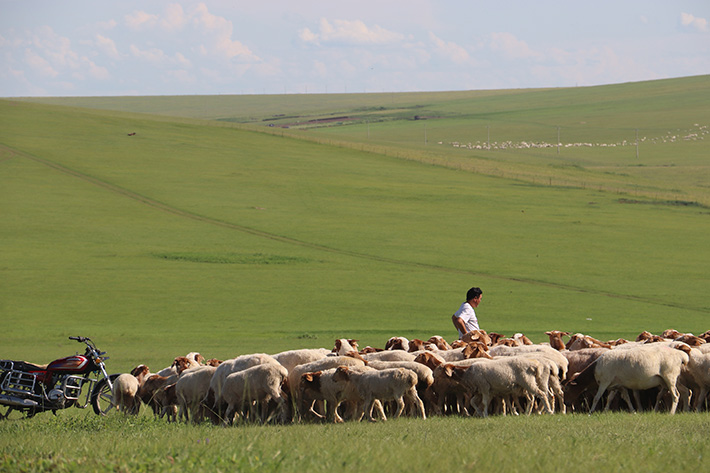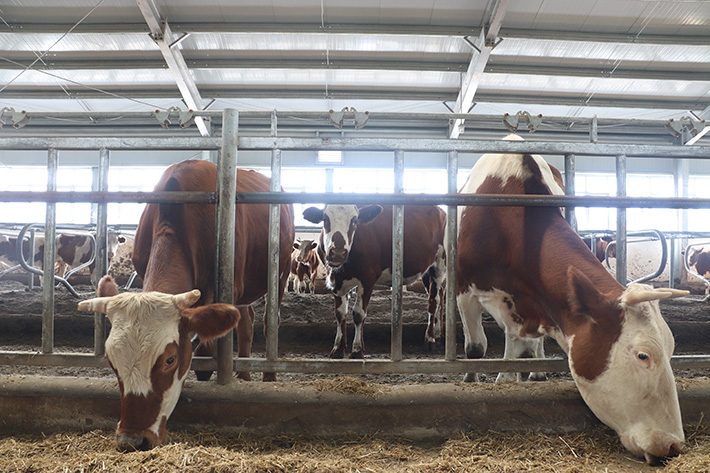|
||||||||||
| Home Top News Economy/Tech Culture/Sports China in Foreign Eyes Green Development Videos Intangible Cultural Heritages |
|
||||||||||
| Home Top News Economy/Tech Culture/Sports China in Foreign Eyes Green Development Videos Intangible Cultural Heritages |
| ChinAfrica |
| Reviving the Grasslands |
| Hulun Buir’s grasslands rebound through modern herding and sustainable, cooperative practices |
| By Li Yin | VOL. 17 October 2025 ·2025-10-10 |

Sheep are grazing at the Red-Headed Sheep breeding base in Old Barag Banner on 1 August (HU FAN)
On the vast Hulun Buir steppe in north China’s Inner Mongolia Autonomous Region, grasslands stretch as far as the eye can see. Known as one of the world’s four great grasslands and celebrated as the “kingdom of flora and fauna in north China,” the region has long been a cradle of traditional nomadic culture and a vital base for animal husbandry.
However, behind the postcard image lies a more fragile reality. Decades of climate change, overgrazing, and traditional herding practices have strained the ecosystem. In some areas, grasslands have degraded, biodiversity has declined, and livelihoods have been put at risk.
In recent years, officials in Hulun Buir, particularly in the livestock-reliant Ewenki Autonomous Banner as well as Old Barag Banner, New Barag Left Banner and New Barag Right Banner, have come to view the fight against overgrazing as essential to the region’s future. Their challenge lies in preserving the ecological balance of the grasslands while improving herders’ incomes.
Hulun Buir has pursued a two-pronged strategy. On one hand, it has launched grassland conservation and restoration programmes, implementing grazing bans and rest-rotation practices to give pastures time to regenerate. On the other hand, it has encouraged measures such as intensive pen feeding, the development of a forage industry, and stronger branding of agricultural and livestock products to cut costs, raise efficiency and increase herders’ earnings.
In Ewenki Autonomous Banner, a modern feed-processing facility illustrates this strategy in action. Machines crush, blend, and package straw, silage corn, and forage grasses into uniform bundles of total mixed ration (TMR) feed. For Mengyuan Agricultural and Animal Husbandry Development Co., Ltd., this technology has become a pillar of its upgrading efforts.
“Compared with natural forage, TMR has multiple advantages,” said Wu Yue, the company’s manager. “This form of feed reduces waste by around 30 percent, provides balanced nutrition, reduces disease risk, and helps livestock to maintain weight and condition even during winter.”
Mechanisation further reduces labour costs, while feed formulas can be tailored to meet the specific nutritional requirements of the animals. Mengyuan makes full use of local resources, recycling leftover straw from harvests and distillers’ grains from alcohol production as raw materials for TMR. The company now produces around 200,000 tonnes of cattle and sheep feed each year, benefitting both its own bottom line and the livelihoods of local herders.
This collaboration between enterprise and community underpins Hulun Buir’s wider strategy. By ensuring a stable supply of feed, the region is easing pressure on natural pastures. At the same time, the feed industry is emerging as a key driver for the modernisation of animal husbandry.

Cattle being fed in a barn at Mengyuan Agricultural and Animal Husbandry Development Co., Ltd. on 1 August (HU FAN)
Branding for profit
Tackling overgrazing addresses only part of the challenge; raising incomes is equally important. To add value to livestock products, and move towards high-quality livestock farming, Hulun Buir is targeting the development of organic, ecological and premium beef and mutton products, with Old Barag Banner’s Red-Headed Sheep as a flagship example.
This traditional local breed, distinguished by its reddish-brown head and neck, thrives in the harsh conditions west of the Greater Hinggan Mountains. Its meat is prized for its vivid colour, firm texture, and high nutritional value. In 2022, the Ministry of Agriculture and Rural Affairs granted Old Barag’s Red-Headed Sheep the status of a nationally certified “New Specialty Agricultural Product.”
A standardised breeding base was established at Huhe Wendu’er Gacha as a pilot project to support the development of collective village economies and enhance herders’ incomes. The facility features management offices, veterinary stations, disinfection units, and sunlit barns, all created to ensure a healthy environment for the animals to flourish.
Each sheep is now fitted with an electronic ear tag, supported by smart drinking stations, entry-and-exit recognition systems, and pasture-monitoring cameras. With the big data monitoring platform established by the Old Barag Banner Bureau of Agriculture, Animal Husbandry and Science, the entire growth cycle of the sheep can be fully tracked. “This system not only helps to prevent overgrazing, but also strengthens the brand and increases incomes,” Wang Jia from the bureau told ChinAfrica.
The initiative has also connected livestock farming with cultural tourism along the Morigele River, positioning the sheep as a premium product grounded in ecological grazing and local heritage. By harnessing both e-commerce and tourism, Old Barag Banner’s Red-Headed Sheep are firmly entering the high-value market.
Reforming the grassland economy
At the core of Hulun Buir’s transformation is the reform of the traditional herding economy. Authorities have introduced policies that turn resources into assets, funds into shares, and herders into shareholders. This approach enables the revitalisation of idle assets and broadens the distribution of development benefits. The model fosters the integration of three core service functions - production, supply and marketing, and credit - forming a new type of rural cooperative economic organisation. It represents an innovative approach to rural economic development.
In Ewenki Autonomous Banner, for example, comprehensive cooperative organisations have created a network of service stations covering all 16 villages.
With 37 grid managers, they cater to herders’ production and daily needs, offering specialised services such as sheep washing, forage storage, and veterinary care, which reduce costs while enhancing animal health. They also manage bulk procurement of supplies and provide cloud-based warehouse logistics and distribution, effectively improving herders’ livelihoods and cutting logistics expenses.
At the same time, the cooperatives work closely with financial institutions to ensure robust financial support for herders’ production and operations. They also deliver free legal guidance, training, and inclusive, policy-driven financial products, providing local herders with a full spectrum of support services.
The results are remarkable: tens of thousands of yuan saved on veterinary services, more than 45 million yuan ($6.32 million) in new sales revenue, and loans exceeding 760 million yuan ($106.81 million) provided to herders at subsidised rates. Hulun Buir has set up 51 village service stations and deployed 160 grid workers to deliver targeted support, helping herders to ease their burdens and boost their incomes.
“These reforms are not just financial,” explained Wang Jingshun, director of the Hulun Buir Academy of Agricultural and Animal Husbandry Sciences. “They address the very real difficulties herders face in vast, sparsely populated grasslands.”
Reforming centuries-old traditions is never easy. Herders have long followed seasonal cycles, and adjusting to new systems takes time. “Hulun Buir has expanded training and demonstration projects, helping herders to understand the benefits of new practices,” Wang told ChinAfrica. Awareness is growing that sustainable grazing, modern feeding techniques, and collective services are not threats to culture, but essential lifelines for survival.
Today, the Hulun Buir grasslands are showing signs of recovery. Pastures are regenerating, livestock are healthier, and herders are beginning to enjoy the rewards of reform. Within the context of China’s broader rural revitalisation strategy, the region is establishing itself as a model of how ecological stewardship and economic development can mutually reinforce one another.
Hulun Buir’s experience offers a compelling lesson for the world: Even under ecological strain and economic challenges, innovation, reform, and cooperation can forge a new chapter for one of the planet’s most remarkable grasslands.
|
||||||||||||
| About Us | Contact Us | Advertise with Us | Subscribe |
| Copyright Beijing Review All rights reserved 京ICP备08005356号-5 京公网安备110102005860号 |